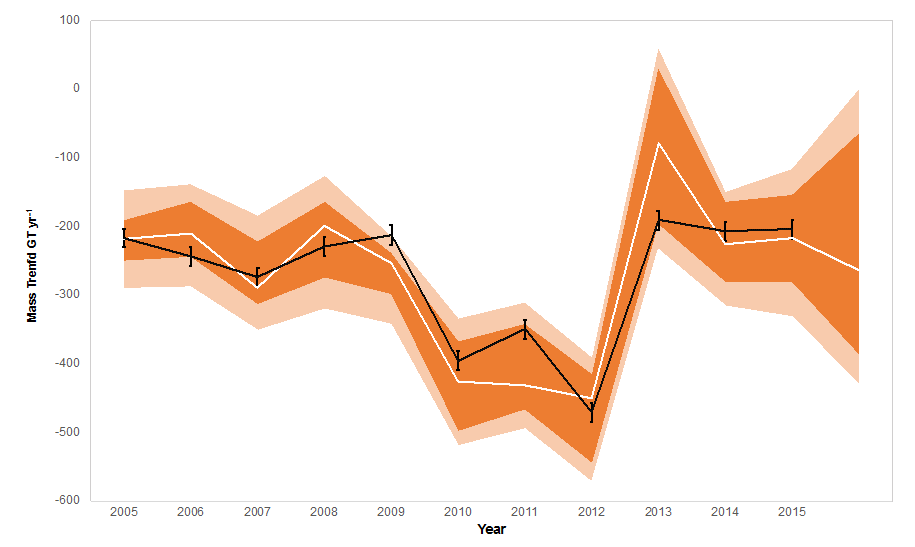The last few months have seen us make progress in two main areas:
(1) Steric sea level change
We have continued to work on what is the first real test of the Bayesian Hierarchical Model (BHM) framework on a global scale – using the framework to ‘predict’ global steric sea level change (see February project update for more details).
It has become clear that the way in which we use observations as ‘inputs’ – and specifically the way in which we define errors associated with the observations – becomes critical to the ability of the BHM to produce physically-realistic outputs. Nowhere is this more important than for the GRACE data which, via measured changes in gravity anomalies, allows us to infer changes in water and ice mass through time.
The GRACE data tends to be heavily processed and is available in multiple formats, so we have spent time ensuring that we (i) are using the most appropriate GRACE data, (ii) understand exactly what processing has been done and (iii) have correctly specified the errors.
In parallel to this, we have also been developing the BHM itself so that it is better able deal with the eccentricities of the GRACE data, by exploring different ways in which we can treat the mass process. For example, whether it is assumed to be ‘stationery’ and treated in the same way everywhere or whether it is assumed to be ‘non-stationery’ and treated in different ways over land and ocean.

Figure 1. An example of how treating the GRACE data in different, yet plausible, ways produces different spatial patterns of predicted steric sea level change. Plot (a) treats the data in the same way everywhere, while (b) and (c) show two contrasting ways of treating land and oceans differently. Plot (d) shows the difference these assumptions can make on the final BHM-predicted sea level trend.
Work on this continues, and we hope to have some first real results early in the summer. If we are satisfied with how the BHM predicts steric sea level change in ocean regions that are already well observed, then we hope to be able to use our results to investigate steric changes in parts of the ocean where there are fewer observations and which are consequently currently less well understood.
(2) Investigating Greenland mass balance using a BHM approach
We have recently produced our first mass balance trends results for Greenland using the BHM framework. However, applying a method developed for Antarctica (in the RATES project) to Greenland has proved more complex than we anticipated. This is mainly because the nature of the processes that govern ice accumulation and melt are very different, requiring them to be incorporated differently and necessitating much code to be rewritten.

Figure 2. Comparison of our current BHM mass trend result (black line) with the weighted mean (white line) and range (orange bars) of other published studies
While the overall mass trend now appears sensible (and fits well against other published studies), a ‘source separation’ issue remains whereby the BHM is not allocating the total change correctly between the two main contributory processes, ice dynamics and surface mass balance. Work is ongoing to develop a method for better separating these processes and to therefore provide more robust results at both ice sheet and basin scales.
Other activities
In February, Zhe Sha attended the Bayes Comp 2018 conference in Barcelona, Spain, where she presented a poster on our recent work using a Bayesian framework to update a forward model of glacial isostatic adjustment (GIA): Bayesian model-data synthesis with an application to global Glacio-isostatic adjustment.
In March, Stephen Chuter represented GlobalMass at the EGU General Assembly 2018 in Vienna, Austria, where he gave a talk on the application of a Bayesian Framework to Greenland and showed some preliminary results (Annual Greenland mass trends from 2003-2015 from a Bayesian hierarchical modelling (BHM) approach). We also presented posters that gave (i) an overview of the project as a whole (First results from an integrated approach for estimating GIA, land ice, hydrology and ocean mass trends within a complete coupled Earth system framework) and (ii) described the new global GPS dataset we have developed for investigating GIA uplift rates (A new global GPS dataset for testing and improving modelled GIA uplift rates).
New publications
Bamber, J.L., Tedstone, A.J., King, M.D., Howat, I.M., Enderlin, E.M., van den Broeke, M.R. and Noel, B., 2018. Land Ice Freshwater Budget of the Arctic and North Atlantic Oceans. Part I: Data, Methods and Results. Journal of Geophysical Research: Oceans. DOI:10.1002/2017JC013605
Bamber, J.L., Westaway, R.M., Marzeion, B. and Wouters, B., (in press). The land ice contribution to sea level during the satellite era. Environmental Research Letters. DOI:10.1088/1748-9326/aac2f0
WCRP Global Sea Level Budget Group (in review) Global Sea Level Budget 1993–Present. Earth System Science Data. DOI:10.5194/essd-2018-53 [the WCRP Global Sea Level Budget Group includes Bamber J.L, Chuter S., Llovel W. and Westaway, R.M.]

